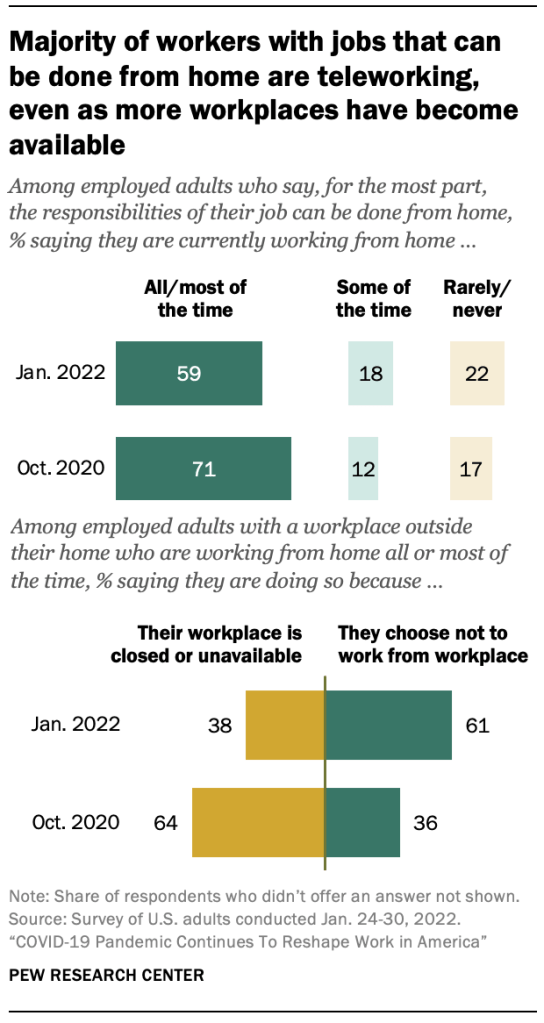How to Transition into a Remote Team in 6 months
How to Transition into a Remote Team in 6 months
One of a company’s biggest challenges is transitioning from a traditional office into a remote team. It must invest a lot in planning to help employees adapt to the new way of working and avoid wasting time on tool installations once the team gets distributed.
In the last six years, remote work increased by 60% in the United States. Even before the pandemic, the companies encouraged employees to work from home; Dell has saved 39. 5 million in real estate costs.
Other big companies like Unilever and Aetna have urged employees to work from home since 2005 because it improves hiring retention and saves 78 million yearly in real estate costs.
Nearly two years into the COVID-19 pandemic, roughly six-in-ten U.S. workers who say their jobs can mainly be done from home (59%) are working from home all or most of the time. According to a new Pew Research Center survey, most workers (83%) say they worked from home even before the omicron variant started spreading in the United States.

But the biggest challenge is to make a definitive transition. Keep in mind the following tips to go remote as successfully as possible.
1. Communication management
Communication is the key to a remote team. It would be best to define what tools you will use to communicate daily. Slack, Discord, Zoom, or Google Hangouts are tools used for remote teams.
These tools offer real-time messaging, video call options, and the ability to organize conversations by channel or department. To learn more about these tools, download the Free E-Book Tools to collaborate with remote teams.
2. Availability
Define a work schedule. When must the team be online? If it is during business hours or if it would be a flexible schedule.
3. Internet connection
Speaking about internet connection, this is one of the main requirements every remote team member must have to perform most of their duties. That is a critical part that companies cannot guarantee unless they are willing to work directly with ISPs.
4. Data Management
Do you have a distributed storage environment where the team can securely organize and share documents and information? There are solutions for every company size, such as Google Drive, Dropbox, Sharepoint, etc., that allow you to manage data across a distributed platform.
These tools, along with SOPs on how to manage the data, will help you stay secure. And if you want added security, VPN solutions can always help, but be careful; VPNs can dramatically affect the user’s speed connection.
- Time tracking: Define how the team will report the time and progress of each task. Tools like JIRA do available modules, such as Tempo, that make time tracking available.
5. Support channels
-
- Who to talk to: It is crucial to define who will be the first contact when the employees need to make requests. Most of the time, an HR analyst must provide support when the team members have doubts about permissions or work policies. The managers also must be able to solve the questions of their teams.
- How to cope with a lack of work environment sociability: One of the most common issues of remote workers is a feeling of disconnection or loneliness. A remote worker interacts with his laptop at home, without coworkers around. To avoid this isolation, the company.
6. Culture integration
A positive culture integration is vital for employee engagement. In remote teams, there are ways to keep the culture integration digitally; having a place for team members to chat casually (such as a Slack channel) can help bring employees together. On this channel, people can share jokes, and birthday ecards, make some contests, or highlight employee achievements.
With the proper planning and preparation described in the previous points, teams can transition to remote work successfully. There will be challenges along the way. Still, it’s essential to let employees find solutions to problems when necessary and suggest how to improve things moving forward.
Bibliography:
https://www.upwork.com/press/2018/02/28/future-workforce-report-2018/
Author Diana Chávez.
Marketing Specialist at TechAID
LinkedIn: DianaChavez
OTHER POSTS YOU MIGHT LIKE
Boosting Efficiency with Nearshore Teams: A Compact Guide
Nearshore vs Offshore Did you know that your decision between nearshore and offshore outsourcing can profoundly impact your team’s productivity, efficiency, and overall success? In the ever-evolving landscape of remote work, it’s crucial to make an informed decision that aligns with your company’s unique needs…
How to choose the right Outsourcing Team for Staff Augmentation
Outsourcing team With the integration of global markets and consumer demands increasing across industries, companies have resorted to outsourcing. Outsourcing refers to the act of a company transferring some of its business to a third party. This can happen with marketing departments, customer service processes,…

